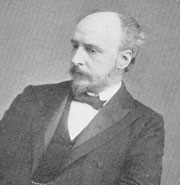Sir James Dewar
Sir James Dewar was born in Kincardine, Scotland, on September 20, 1842, the son of an innkeeper. He attended local schools until he was ten when he suffered a serious case of rheumatic fever lasting two years. During this period he built a violin, and music remained a lifelong interest of his. In 1858 he entered the University of Edinburgh. There he studied physics and chemistry. Dewar, in an early display of his dexterity, developed a mechanical model of Alexander Crum Brown's graphic notation for organic compounds. This was sent to Friedrich Kekulé in Ghent who then invited Dewar to spend some time in his laboratory.
After holding a number of chemical posts in Scotland, Dewar was appointed Jacksonian Professor of Natural Philosophy at the University of Cambridge in 1873, and four years later he was appointed Fullerian Professor of Chemistry at the Royal Institution. He held both chairs concurrently, but spent most of his time in London. At Cambridge he collaborated with George Downing Liveing on an extensive spectroscopic study linking spectra with atomic and molecular states. This led to a very public disagreement with Norman Lockyer about the dissociation of matter in the Sun and stars. One of Dewar's chief characteristics was his ability to engage, at times, in quite vitriolic arguments with other scientists; Robert John Strutt, the fourth Lord Rayleigh wrote that to argue with Dewar was akin to being a fly in molasses.
At the Royal Institution, Dewar found himself at the intersection of major scientific networks involving the government and industry. He thus collaborated in the late 1880s with Frederick Abel on the invention of the explosive cordite. Nevertheless, at the Royal Institution Dewar focused almost entirely on cryogenics. In 1877 oxygen had been liquefied in France, and the following year Dewar demonstrated this for the first time in England at a lecture at the Royal Institution. New methods for obtaining low temperatures were developed in the 1880s, but Dewar's ability to take advantage of these methods was restricted by his not being fully in charge of the Royal Institution. However, after forcing John Tyndall's retirement in 1887, Dewar became the director of its laboratory. He improved low-temperature methods, especially by the application of the Joule–Thomson effect that produced much lower temperatures. Dewar had now turned his attention to hydrogen, which he could not liquefy even at the low temperatures obtainable.
In the mid-1890s Dewar was responsible for one of the most important developments in the history of the Royal Institution: the establishment and endowment of the Davy–Faraday Research Laboratory of the Royal Institution. This not only entailed the acquisition of a new building, but also the direct support of Dewar's cryogenic research. Success came in 1898 when he finally liquefied hydrogen. However, in the race with Heike Kamerlingh Onnes at the University of Leiden to liquefy helium, Dewar lost and the Nobel Prize went to Kamerlingh Onnes. Although Dewar was nominated several times, he never won the coveted prize.
One of the consequences of Dewar's work was his invention of the vacuum flask to minimize heat loss. It was expensive and time-consuming to liquefy gases; hence, Dewar designed a container where, once liquefied, gases could be kept for as long as possible. Still known as the Dewar flask among chemists, it is more widely known as the Thermos, named after the company that obtained the patent for the flask and to whom Dewar lost an ensuing court case.
Dewar's later work involved investigating the chemical and physical properties of substances at low temperatures, including low-temperature calorimetry. With the outbreak of the Great War (or World War I, 1914–1918), the laboratory at the Royal Institution lost most of its staff and Dewar turned his attention to soap bubbles. By the end of the war Dewar, now in his late seventies, did not have the energy to restart the laboratory, nor would he retire. He died on March 27, 1923, and his funeral service was held in the director's flat at the Royal Institution.
Source: http://www.chemistryexplained.com/Co-Di/Dewar-James.html
Question: What connects superconductors (used in MRI scanners and mag-lev trains) with vacuum flasks (used by businessmen and old women)?
Answer: James Dewar.
If ever you hear anyone doubt that what all scientists produce is of little value to the average John Doe on an average day in an average city, then just think of James Dewar. Think what his studies on liquification of gases have led to in terms of practical everyday inventions. Think of what they have allowed us to do:
- They have allowed us to travel on super-fast, super-smooth mag-lev trains to commute to work and back.
- They have allowed us to have our brains scanned for signs of tumours & cancerous growths.
- They allow us to sit at car-boot sales (or flea markets/swap meets) and sup hot cups of tea in the cold mid-Winter.
[End.]

No comments:
Post a Comment